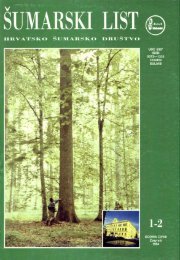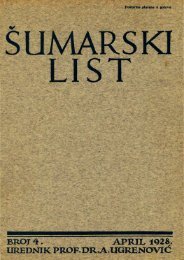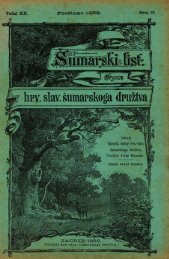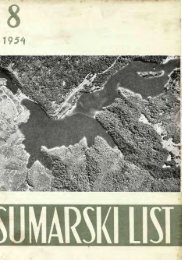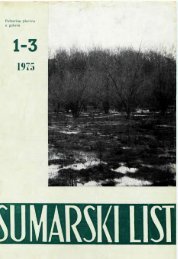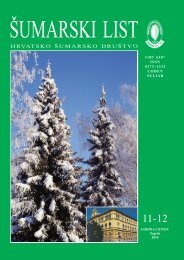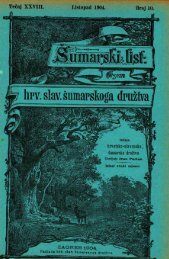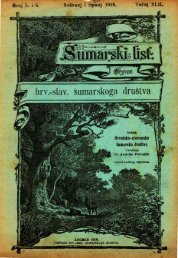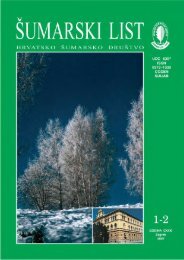tivnost borovca dolazi do izražaja to više. što je produkcioni proces kraći. Tonam ilustriraju odnosi drvnih masa tih dviju vrsta drveća u pojedinim godinamastarosti, koji nam kažu, da je drvna masa borovca u 20, u 30. i u 40.godini oko 4 puta veća, a u 50. i 60. godini oko 3 puta veća od drvne mase hrastakitnjaka u istoj starosti. U kasnijim godinama drvne mase obiju vrsta drvećaće se vjerojatno izjednačiti. Iz toga proizlazi zaključak, da Pinus Strobus dolaziu obzir za proizvodnju tankih sortimenata u odgovarajućim ekološkim prilikamai gdje nema opasnosti od Cronartium ribicola.LITERATURA:Anić M.: O zelenoj i plavoj duglaziji s naročitim obzirom na. bolest Rhabdocline,Šum. list 1933.Fourchy P.: Etudes sur le developpement et la production de quelques peuplementsde Douglas, Annales de l'Ecole Nationale des Eaux et Forets, Nancy 1954.Gessel P. Turnbull J. K. Tremblay T. F.: How to fertilize trees and measure response,1960.Gore K.: Die Douglasie und ihr Holz, 1958.Giiinier, Oudin, Schaeffer: Technique forestiere, 1946.Hawley R. C, Smith D. H.: The pactice of Silviculture, New York, 1958.Hengst E,: Allgemeine Bemerkungen zur Weymouthskiefer und zu ihrer Form,Archiv für Forstwesen, 1959.Horvat I.: Prilog poznavanju tehničkih svojstava duglazijevine, Šum. list 1953.Hummel F. C, Christie J.: Revised Conifer Yield Tables for Great Britain, 1953.Kišpatić J.: Dvije bolesti Duglazije u našoj državi, Šum. list 1952.Köstler J.: Silviculture, 1956.Me Arđle, W. H. Meyer, D. Bruce: The Yield of Douglas Fir in the Pacific Northwest,Washington D. C, 1949.Marković Lj.: Zelena duglazija u Srbiji, Savezna uprava za unapređenje proizvodnje,1951.Munger T. T.: The groth and Management of Douglas fir in The Pacific Northwest,U. S. Dept. Agr. For. 1911.PARDE J.: Dendrometrie, 1961.Perrin H.: Sylviculture, tome I, II i III.Piškorić O.: Četinjače u okolini Rovinja, Šum. list br. 12, 1946.Piškorić O.: Zelena duglazija na Krasu, Šum. list br. 7—8, 1955.Piškorić O.: Duglazija kao vrsta ekonomskih sastojina na degradiranom dijelu Krša,Šumarski list br. 11-12, 1960.Pourtet J.: Veštačka pošumljavanja, Beograd 1948.Radulović S.: Duglazija u svetlosti podataka njenog razvoja na Avali, Šumarstvobr. 9—10 od 1960.Wiedemann — Schober: Ertragstafeln, 1957.Tregubov V.: Duglazija, Savezna uprava za unapređenje proizvodnje, 1951.Urbas J.: Egzote v gozdnem gospodarstvu Slovenije, Pola stoljeća šumarstva,Zagreb, 1920.FAO: Le choix des essences forestieres, Rome 1960.A CONTRIBUTION TO THE KNOWLEDGE OF DOUGLAS FIR AND EASTERNWHITE PINE INCREMENTIn Yugoslavia and especially in Croatia there are to be found many DouglasFir and Eastern White Pine stands of various ages. Therefore we had an opportunityto investigate how do these American species grow in our country.First we found out that the Cubic — Foot Volume Table for second — growthDouglas Fir, established by Mc Ardle, H. Meyer and D. Bruce (Tab. No 3) is applicablealso to our Douglas Fir stands.In the Table No 5 are given data on the increment of Douglas Fir Stands ofvarious ages ranging from 22 to 70 years. The current annual increment variesfrom 8,3 to 18.5 cu. m/ha. We found out that a high productivity c,i Douglas Fir30
can be expected only under favourable ecological conditions as interpreted byFourchy in France. This was proyed in our 70 — year — old stand »Pičulin« (seep. No 11) growing on a rich, deep and porous soil in the River Valley of theGorski Kotar Regien. In this stand the current annual increment amounts to ca18,5 cu. m/ha; the volume of the standing crop being 678 cu. m/ha and the meand. b. h 43.5 cm; the top height is about 40 m. However the productivity of DouglasFir in our stands is lesser than that given in the Yield Tables by Hummel, Christiand Schüber. There are many reasons for this: Douglas Fir planted was in theselocalities without regard to the edaphic conditions, the stands being too dense, thethinnings too moderate etc.For Eastern White Pine we found out that the Volume table, established byHengst in Germany can be applied to our Eastern White Pine stands (see Tab.No 6).Increment data of the investigated Eastern White Pine stands are to be found inTab. No 8. The current annuel increment ranges from 9,3 to 20,6 cu. m/ha.For the purpose of comparison of the growth of Eastern White Pine to thatof the Oak (Quercus sessiliflora), we made an analysis of two stems — the one ofEastern White Pine and the other of Oak — grown side by side under the sameconditions in the menagement unit of »Našička Planina«. The results of the stemanalysis (height growth at left, diameter growth in the middle and volume growthat right) are given in Fig. No 4 in which number (1) represents the growth of EasternWhite Pine and (2) the growth of Oak.In spite of a high productivity of Eastern White Pine it is recommended to usethis species only for the production of small dimension assortiments and this inthe localities which are not exposed to the hazards of Cronartium ribicicola.Kad se ovaj članak štampao, naišli smo na Häusserovu tablicu drvnih masa zazelenu duglaziju u Pardeovoj dendrometriji. S obzirom na to. da je Hausserovatablica praktičnija od Me Arđlove, donosimo je u tabeli 3a, u toliko više, što smo natemelju nje izračunali u Zelendvoru drvnu masu od 453,4 m 3 /ha, tj. gotovo isto kaoi po Me Arđlovoj tablici.31




